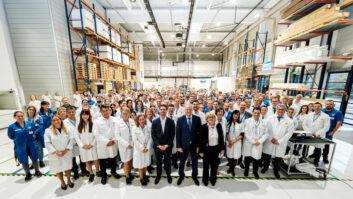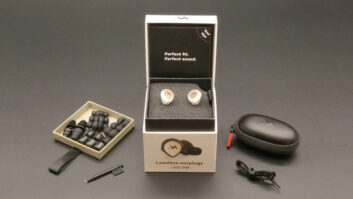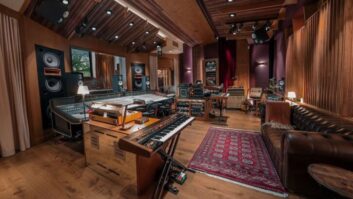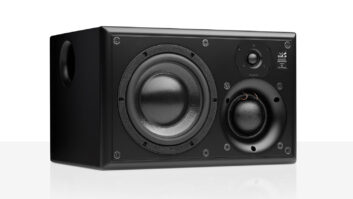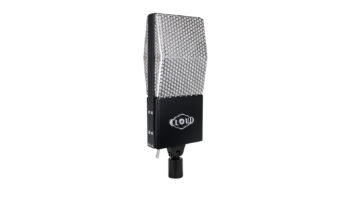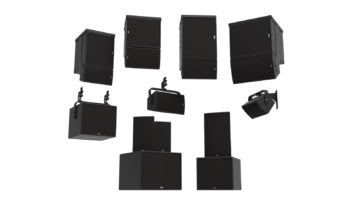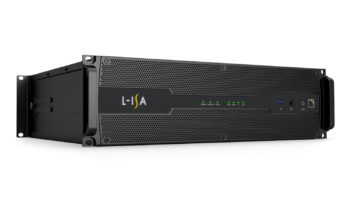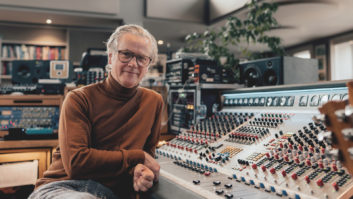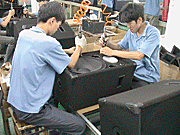
At one time, quality was tied in with price: The pro/high end paid high prices simply because the hardware was expensive to build and, by even the most jaded, subjective standards, it sounded better. Now, with PCs dominating the workspace, buyers increasingly equate quality with a price/performance ratio. While the new generation may have reverence and respect for boutique gear and $4,000 mics, they are equally likely to rave about $99 mics made in China or a $149 dynamics plug-in.
Following classical economics, a finished product’s price will reflect costs of design, materials, manufacturing, marketing, distribution and after-sales support. And a product’s viability — whether an interface cable or a multichannel console — depends on a number of time, market and product-specific factors. But in the New Economics, we find the high end moving down the market and the entry level turning pro. Traditional hardware companies are leaping into software and entry-level software vendors are becoming players. There are lower manufacturing costs but higher R&D investment, with code writers co-existing with electrical engineers. And we find end-users clamoring for features but unwilling to pay more than “x” dollars.
It used to be so simple.
THE AFFORDABLE HIGH END
“It is inevitable that over time in a free-market economy, manufacturers will increase production and reduce prices,” says Stephen Woolley, president of MTSi and formerly with such companies as IAG, Wharfedale Pro, Gibson, Fender and Panasonic. “At the start of any business, there is only one ‘first hammer’ or the ‘first loudspeaker’ at its own price. Then things develop to where there exists a spectrum of price:performance in products that cover all of the price levels that the market will support.”
Today’s customers are highly price-conscious, Woolley continues, “with loyalty only for brands that they perceive as giving value. If these products are inferior in any significant way or if they do not offer some significant and readily perceivable value, the manufacturer will fail. Competition ultimately forces differentiation — either through superior features and performance at a price, or the same specs as everyone else at a lower price.”
“We are really considering the perceived value of a product — what it can achieve for the buyer and how the brand will carry a level of respectability to the facility purchasing it,” adds Lance Korthals, an L.A.-based business and marketing consultant who has held positions with such companies as dbx, Lexicon, JBL Professional and Spectral. “We ask ourselves, ‘What are the features and functions we need to offer at that price point?’ And then, ‘Can we design and produce it for the requisite cost?’ If the answer is no, what are the trade-offs? Will customers accept the product if we leave out some features in an initial release to hit the target price and maybe add more functionality in subsequent upgrades?”
More and more high-end brands are realizing that they need to offer a spectrum of price choices. Even mic manufacturer Neumann is responding to the budget-conscious market. “Our new TLM103,” says Wolfgang Fraissinet, president of marketing/sales, “was designed with fewer features and uses surface-mount technology to help reduce manufacturing costs, without compromising sonic quality.”
Solid State Logic recently broadened its product range with the introduction of the AWS 900 Analogue Workstation System, which combines a multi-input analog console with integrated DAW control. “When we set a target price for the AWS 900, we based it on a definition of what users would need as a high-end production tool kit for a project studio,” says director of product marketing Niall Feldman. “To meet the $85,000 target price and still build to the same quality standards of the larger consoles, we decided to offer a standard configuration using channel strips based on our XL 9000 console modules. For users, the key ingredients were quality of audio performance, build quality and the quality of the user interface’s look and feel.”
Euphonix has also looked at the high-end music recording market and concluded that value for money is vital for today’s commercial facility and project studio owner. “The DAW is now an integral part of any music session, so it was natural for us to devise a way for our console surfaces to directly communicate via high-speed Ethernet with a workstation,” explains Andy Wild, VP of marketing. “Our new System 5-MC uses the familiar System 5 as a control interface for any EuCon- or MIDI-compliant workstation, such as Nuendo, Pyramix and, via HUI-format commands, Pro Tools, Logic 7 and other platforms. The result is a high-quality, powerful digital mixer and editing system that costs much less than a high-end analog or digital console.”
JBL Professional, one of Harman International’s key brands, is also positioned at the upper end of the price:performance spectrum. “The quality of monitor systems cannot be compromised,” stresses VP of marketing Mark Gander. “For the live sound and touring markets, we have been faced with competitive cost challenges, but have been able to respond with new manufacturing efficiencies, as well as new transducer and cabinet technologies. For example, our patented Differential Drive transducers with twin voice coils and magnetic gaps — innovated five years ago for the VerTec Series line arrays — are now being used in the SRX Series available through music stores and the VRX, or ‘Junior VerTec,’ which allows users to take advantage of line array performance efficiencies but in a smaller package.”
ADAPTIVE STRATEGIES
Costs, many of them unplanned, can rise at any time during a manufacturing cycle, but fabrication is one expenditure that can be reduced. A growing number of pro audio companies are now manufacturing in Asia, where labor costs can be significantly lower than in North America or Europe. Or they are setting up factories there themselves. “When managed properly, the manufacturing location does not matter,” Korthals stresses. “Just so long as the manufacturing firm pays strict attention to meeting the company’s established quality standards and the company understands their production requirements, you can factor that into the product.”
Products that are mature in their product cycle and based on well-evolved technologies — passive loudspeakers and some types of microphones come to mind, as well as simple analog mixers and power amps — can now be considered stable components within a highly competitive marketplace. Their implied commodity status means that they are capable of being produced by a large number of companies, and the result is a large, highly competitive market in which unit costs can be dramatically reduced. The value for money offered by these products can be outstanding.
“It’s an old adage, but ‘know your customer’ applies now more than ever before,” Korthals says. “Manufacturers must understand the sensibilities of the market and the end-user. The brand name creates an expectation, and inferior — but maybe cheaper — products can easily tarnish that expectation. Having established a premium brand, it would be unfortunate to weaken that image with inferior, ‘me too’ products.”
“For us, the key to success is a combination of technical innovation and manufacturing efficiency,” JBL’s Gander adds. “We perform a lot of pure research on the JBL campus [Northridge, Calif.] that might not have any immediate commercial applications, but which helps keep us ahead of the innovation curve. We also have a worldwide support network for our almost 60-year-old company, as well as high connectivity with other Harman brands via our new HiQnet command protocol. The quality of experience that we deliver is key to understanding why JBL products might cost more than the competition, but offer far stronger user commitment.”
JBL’s infrastructure is complex and expensive to fund. “We have a number of areas on our campus that represent a substantial financial investment,” adds Peter Chaikin, JBL director of recording and broadcast products, “including four anechoic chambers and a computer-controlled ‘Speaker Shuffler’ that we can use to perform double-blind A-B testing of prototypes and production samples. All of that investment is reflected in the quality of our products. We offer products that extend from the hobbyist through midrange to high-end systems [that] are very cost-competitive in terms of performance and features for the price.”
Loud Technology, with its Mackie, EAW and Tapco divisions, straddles a number of price ranges with similar products. “In terms of branding, we position EAW as a very high-end brand [of live performance and installed sound loudspeakers, amps and processors], Mackie as a very high-value supplier of production hardware with a focus on physical reliability and dependability and Tapco as our entry-level line of high-value MI products,” says Ken Berger, senior VP of marketing. “Because of lower manufacturing costs, the majority of our products are made in Asia. We have found that quality standards have gone up, not down. We have partnered with [Chinese] companies that fabricate just our products. That way, we can maintain high-build qualities that meet our sonic standards. We strive for quality at every level.”
Digidesign has set many quality benchmarks for its Pro Tools Series DAW software, not to mention the new ICON. “The primary reason for offering Pro Tools|HD and its companion I/Os was to dramatically increase the price:performance curve by providing the highest end-to-end audio quality at the most affordable price,” says Wendy Abowd, Pro Tools product line director. “It shouldn’t be forgotten that there is quite a bit more to a premium-quality converter system than just the ADC or DAC chip. The power supply, clock and audio circuitry are critical. Our product quality also includes the reliability and support that we offer. Part of our brand equity is also recognizing our existing customers’ investment. To help soften the upgrade cost [to Pro Tools|HD], we implemented a new hardware exchange program, something we’ve done since 1996. We also invest a lot of time in our third-party plug-in developer program.”
Apple believes in a tiered product offering, with brand quality and support enabling potential buyers to start small and upgrade as their needs develop. “For the last 14 months, we have been shipping GarageBand with every new Macintosh,” explains Kirk Paulsen, senior director of pro application marketing. “GarageBand uses the same basic DSP engine as our Logic Series 7 DAWs, so customers can take early projects and make use of the latter’s enhanced features.” Brand value comes from both the high-quality GarageBand samples — the new Steinway piano files run to 2 GB each — and the upward mobility available to a Logic Express customer, who can upgrade to Logic Pro for the price differential.
Max Gutnik, Apogee Electronics’ director of sales, says that one of the firm’s biggest challenges is to develop products that can reach into the project studio market without compromising quality. “We have a good reputation for offering expensive, high-end A-to-D and D-to-A converters,” he says. “We need to maintain that brand equity for price-conscious segments.”
One way is to create innovative designs that lower the cost without compromising sound and build quality. For example, Apogee has designed a new Synchronous Switching PSU for all of its latest converters. Not only does such a unit offer better transient response and efficiency than a traditional linear power supply, Gutnik claims, but the cost is around 75 percent less. “Also, because the supply produces less heat, we can package it into a compact, 1U chassis, without the need for fans,” he says.
Cost efficiencies can come from a number of areas. E-mu Systems offers software versions of its MI products, plus PCI- and PCMCIA-based sound cards that run them, and can take advantage of its ownership by Creative Labs. “Since Creative [Labs] is probably the world’s largest manufacturer of sound cards, computer audio accessories and similar consumer hardware,” explains Derk Hagedorn, E-mu marketing manager, “we can procure components at lower prices than the competition. For example, our 1820M digital audio system uses the same 24/192 A-to-D converter [ICs] as [Digidesign’s] Pro Tools|HD 192 I/O interface, but sells for far less.”
Within the highly subjective microphone market, Marshall Electronics’ MXL range of low-cost models is made in Asia and has earned a loyal following from producers and engineers. “Our users tell us that they sound as good as German-made microphones that cost 10 times as much,” says Wayne Freeman, director of sales and marketing for Marshall. Freeman also considers the retail look and feel of a lower-cost item to be paramount. “Good packaging is vital,” he says. “Customers expect a certain level of design that confirms their sales purchase. We maintain high-quality standards from our supplier.”
HARDWARE MEETS SOFTWARE
Hybrid hardware/software solutions present a unique challenge. While the fabrication of conventional hardware-based systems is normally labor-intensive, software applications require more ongoing R&D and updates, but are cheap to manufacture and package. Living in a hybrid market sector can be complicated.
Until recently, Eventide had been a hardware-based company selling audio processors to recording and production facilities through select dealers. Introducing TDM plug-ins for Pro Tools two years ago, the company had to ensure that the brand would be relevant to its new offerings. “We made sure that the plug-ins carry the same audio quality as our processors, but with an appropriate price:performance value,” says Ray Maxwell, Eventide’s VP of sales and marketing. “By developing the software in-house and designing and printing the packaging using local sources, we can maintain quality.”
A recent marketing ploy comprises Eventide’s Anthology bundling of all nine TDM plug-ins. “Individually, these plug-ins would sell for $2,875,” Maxwell says, “but we discount that to $1,195 retail, which translates to a street price of under $1,000. Now, dealers can include Anthology with each Pro Tools sale. This strategy grows our install base.”
And E-mu believes that performance speed is a major selling advantage. “We offer a hybrid solution and lock the software instruments to our hardware,” explains Hagedorn. “To ensure that our instruments run as fast as possible, we add custom ASICs that accelerate performance and can provide zero-latency monitoring, which cannot be done natively.”
“For the majority of pro audio products,” Digidesign’s Abowd says, “the price:performance ratio will continue to fall; users will continue to expect more for less. It’s essential that we clearly tell each customer how our new offerings and features can increase their productivity and creativity. We are innovating and improving price:performance all the time, but we need to recognize that our professional customers need to integrate software and hardware changes in discrete steps. Because production facilities and project facilities need stability — they cannot afford to upgrade continuously — the timing of our updates and upgrades is very important.”
Cakewalk’s SONAR 4 digital audio workstation software was designed specifically to run on a number of Windows-compatible platforms. “By remaining totally hardware-independent,” says marketing director Carl Jacobson, “we can leverage customer interest with our integration of [ASIO-compliant] Pro Tools hardware, as well as OMFI file-format support and preset QuicKey macro commands. This is a key issue for users with significant hardware investments who want in on what our software delivers.”
“Our branding is based on a combination of ‘analog ears and digital minds,’” explains Matt Ward, president of Universal Audio, a company that straddles both markets and offers the UAD-1 DSP card platform for native-based DAWs. “We emphasize that high-quality products do not have to be expensive. Traditionally, the average price for one of our analog products has been around $2,000, but recently, we have leveraged our reputation for high sound quality into a range of lower-cost systems that help us move into broader markets.
“At AES 2004, we introduced the LA-610: a ‘channel strip’ product with a single-channel mic preamp and an LA2-like compressor for $1,749, which translates to a street price of around $1,400. We have reduced some features but not sound nor build quality. We looked at the channel strip market and realized that there was nothing in the price range we were targeting, but that target price had to be based on an enhanced sales quantity to recover our investment in R&D and manufacturing.”
SOFTWARE MINDSET
With the majority of audio production migrating to workstations and integrated systems, the quality of application features and functions becomes arguably more important than the host hardware. Costs cover a broad spectrum, with most DAWs shipping with onboard and third-party plug-in bundles.
Waves started life 12 years ago as essentially the first third-party plug-in manufacturer; it now leads the market. “When developing new plug-ins,” says Garrett Soden, director of pro audio marketing at Waves, “we research new opportunities; we are not a ‘me too’ company. Our pricing reflects the fact that we look for different solutions that do something new and useful. Quality for us is the driving force: sonic quality, of course, but also the quality of the user interfaces and the quality of our software code.”
“Our perceived value for cost as a software vendor,” reflects Cakewalk’s Jacobson, “is through the affordability of our upgrades, our commitment to full customer service and the fact that we ship stable products on time and with feature sets that our customers expect. We aim to communicate this value proposition through consistency of delivery in our messaging — and targeted advertising for different segments.”
Cakewalk’s recent announcement of x64 Technology Preview— a native 64-bit version of SONAR 4 Producer Edition — demonstrates that commitment to leading-edge developments. As Steve Pitzel from Intel’s Media Segment Strategy explains, “We are working closely with companies like Cakewalk to develop software that runs on our Pentium 4 processor with 64-bit extensions. We have also developed Software Developer Toolkits and other programming aids to help DAW manufacturers take advantage of the enhanced sonic quality and sample size benefits [up to 1 Terabyte] available with native 64-bit Intel processing.”
Because recording and production tools can now be manufactured more efficiently and cheaply, there is a temptation to equate affordability with reduced quality of construction and diminished audio quality. Nothing could be further from the truth. Quality depends on a number of factors, ranging from new manufacturing efficiencies to radical changes in the underlying technology available to today’s budget-conscious generation of producers, engineers and musicians.
Mel Lambert (www.mel-lambert.com) heads up Media&Marketing, a full-service consulting service for pro audio firms and facilities.
WHERE TO BUY, HOW TO BUY
Remember when mixers, tape machines, microphones, monitors and outboard gear were purchased through dealers supported by regional manufacturers’ reps? And high-capital items came factory-direct? Well, with the lower cost of entry brought on by DAWs and the commoditization of peripherals, most engineers are just as likely to head to a superstore or purchase pro products online. The specialty pro audio dealer hasn’t altogether disappeared, but it is harder to find. “Unfortunately, if you’re not available at Guitar Center — or through its [Internet e-business portal] Musician’s Friend — you are not in the pro audio business!” says Wayne Freeman, director of sales and marketing at Marshall Electronics.
“Pro audio users make purchases based on a product’s applicability to the planned application,” says David Angress, executive VP of Guitar Center and GC Pro. “Key factors are reliability and dependability, in addition to the bottom-line price. GC Pro follows a business-to-business modality that you will not find at a conventional retail store.
“Our account managers work from 15 locations [within Guitar Center stores] in major metropolitan areas and help customers stay up-to-date on new products, upgrades and compatibility issues,” he adds. “And we can leverage Guitar Center’s bulk-buying power, inventory and national reach to offer products at very competitive prices.”
Today’s customer is absolutely looking for lower prices, which tends to favor the bulk purchaser. “The larger outlets do offer stronger buying power from manufacturers, which cannot be matched by mom-and-pop stores,” says Dave Malekpour, head of Professional Audio Design.
It is unusual for a dealer to also serve as a distributor, but Malekpour sees user advantages in his PAD dealership co-existing with AXI, which distributes six lines, including the in-house — designed and manufactured Resolution Series. “But you cannot mass-market high-end, hand-built products without support,” Malekpour stresses. “We recognize the fact that today’s market needs real service engineers on call to demonstrate the products and offer a higher level of support before, during and after the sale.”
Ken Berger, senior VP of marketing at Loud Technologies, agrees. “The MI market will accept a reasonably technical product just so long as we have phone support for music store customers. But EAW customers have entirely different needs, including application support before a sale. We use retail dealers for the Mackie line of analog/digital mixers, loudspeakers and accessories.”
Mackie/Loud, with its range of brands across all price points, takes advantage of all sales avenues. Cakewalk, meanwhile, takes it even further. According to marketing director Carl Jacobson, Cakewalk’s economies come from broad distribution via bricks-and-mortar locations, including Guitar Center and Sam Ash; distribution agreements with Roland and Edirol; and online upgrades for existing customers. “We do factor in free online and telephone technical help — an essential commitment for the broad range of customers we target,” Berger says.
And then there are manufacturers that employ a more personal, direct touch. “We focus more on boutique music stores and knowledgeable dealers that understand the principles of digital audio,” says Apogee director of sales Max Gutnik. “The market needs evangelists to explain the difference between converter brands — the quality advantage — and educate the user on how to best use our products. The more a customer knows about sound quality, the more they will tend to buy an Apogee product.”
The choice of technology might need to also be seen in a wider perspective. As Fletcher, a high-profile consultant with Boston-based boutique dealer Mercenary Audio, advises, “The first thing we ask our customers is, ‘What are your priorities/goals?’ And, ‘Where is the sense of aesthetic for the project?’ Then hopefully advise them on choices of appropriate hardware. Our product line is unusual — all the gear we sell has ‘personality’ — but we won’t sell a product if we don’t think it’s the best tool in its weight class.”
— Mel Lambert
